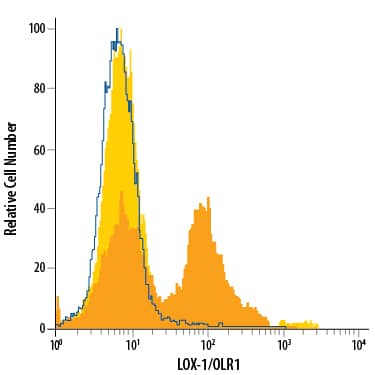Human LOX-1/OLR1 Alexa Fluor® 488-conjugated Antibody
R&D Systems, part of Bio-Techne | Catalog # FAB1798G


Key Product Details
Validated by
Species Reactivity
Applications
Label
Antibody Source
Product Specifications
Immunogen
Ser61-Gln273
Accession # P78380
Specificity
Clonality
Host
Isotype
Scientific Data Images for Human LOX-1/OLR1 Alexa Fluor® 488-conjugated Antibody
Detection of LOX‑1/OLR1 in THP‑1 Human Cell Line by Flow Cytometry.
THP-1 human acute monocytic leukemia cell line either untreated (light orange filled histogram) or treated with 50 ng/mL PMA for 3 days (dark orange filled histogram) was stained with Mouse Anti-Human LOX-1/OLR1 Alexa Fluor® 488-conjugated Monoclonal Antibody (Catalog # FAB1798G) or isotype control antibody (Catalog # IC0041G, open histogram). View our protocol for Staining Membrane-associated Proteins.Applications for Human LOX-1/OLR1 Alexa Fluor® 488-conjugated Antibody
Flow Cytometry
Sample: THP‑1 human acute monocytic leukemia cell line treated with PMA
Formulation, Preparation, and Storage
Purification
Formulation
Shipping
Stability & Storage
- 12 months from date of receipt, 2 to 8 °C as supplied.
Background: LOX-1/OLR1
Lectin-like oxidized low-density-lipoprotein receptor-1 (LOX-1), also known as oxidized low-density-lipoprotein receptor-1 (OLR-1), is a type II transmembrane receptor belonging to the C-type lectin family (1). It also belongs to the functionally defined scavenger receptor (SR) superfamily, whose members share the common ability to bind and internalize modified forms of Low Density Lipoproteins (LDL) (2-4). LOX-1 is the first member of the class E scavenger receptor subfamily (SR-E). It binds and supports the internalization of multiple structurally unrelated macromolecules including oxidized LDL, advanced glycation end products (AGE), activated platelets, bacteria, apoptotic or aged cells, and heat shock proteins (5-7). LOX-1 has also been implicated as an intestinal receptor involved in the transcytosis of pancreatic bile salt-dependent lipase (8). The human LOX-1 gene encodes a 273 amino acid (aa) residue protein with a short N-terminal intracellular domain, a transmembrane domain, an extracellular stalk/neck region followed by a C-type lectin-like domain (CTLD) (1, 6). The CTLD, which is required for ligand recognition, contains the six conserved cysteine residues present in all C-type lectins, but lacks the Ca2+-binding residues found in classical C-type lectins. LOX-1 can be detected on activated endothelial cells, vascular smooth muscle cells, macrophages, intestinal cells, and dendritic cells (6-8). The expression of LOX-1 is induced by proinflammatory or proatherogenic stimuli, as well as by oxidized LDL itself and hemodynamic or oxidative stress. Human LOX-1 exists on the cell surface as covalent homodimers, which can further associate into non-covalent-linked oligomers (9). Cell surface LOX-1 can also be cleaved by yet unidentified proteases to release the soluble LOX-1 extracellular domain (6). Binding and endocytosis of oxidized LDL by LOX-1 induces oxidative stress, activates NF kappaB, and upregulates the expression of monocyte chemoattractant protein-1 and matrix metalloproteases (5-9). LOX-1-dependent oxidized LDL uptake also induces apoptosis by inducing the expression of the pro-apoptotic Bax and downregulation of the anti-apoptotic Bcl-2 (10). Oxidized LDL plays a key role in the pathogenesis of atherosclerosis and endothelial dysfunction. Blockade of LOX-1 functions may turn out to be a suitable target for the therapeutic intervention of atherosclerosis.
References
- Sawamura, T. et al. (1997) Nature 386:73.
- Daugherty, A. et al. (2000) Curr. Opin. Cardiovasc. Pulm. Ren. Invest. Drugs. 2:223.
- Platt, N. and S. Gordon (2001) J. Clin. Invest. 108:649.
- Platt, N. and S. Gordon (1998) Chem. Biol. 5:R193.
- Jono, T. et al. (2002) FEBS Lett. 511:170.
- Kume, N. et al. (2001) Curr. Opin. Lipidol. 12:419.
- Delneste, Y. et al. (2002) Immunity 17:353.
- Bruneau, N. et al. (2003) Mol. Biol. Cell 14:2861.
- Xie, Q. et al. (2004) DNA and Cell Biol. 23:111.
- Chen, J. et al. (2003) Circ. Res. 94:370.
Long Name
Alternate Names
Gene Symbol
UniProt
Additional LOX-1/OLR1 Products
Product Specific Notices for Human LOX-1/OLR1 Alexa Fluor® 488-conjugated Antibody
This product is provided under an agreement between Life Technologies Corporation and R&D Systems, Inc, and the manufacture, use, sale or import of this product is subject to one or more US patents and corresponding non-US equivalents, owned by Life Technologies Corporation and its affiliates. The purchase of this product conveys to the buyer the non-transferable right to use the purchased amount of the product and components of the product only in research conducted by the buyer (whether the buyer is an academic or for-profit entity). The sale of this product is expressly conditioned on the buyer not using the product or its components (1) in manufacturing; (2) to provide a service, information, or data to an unaffiliated third party for payment; (3) for therapeutic, diagnostic or prophylactic purposes; (4) to resell, sell, or otherwise transfer this product or its components to any third party, or for any other commercial purpose. Life Technologies Corporation will not assert a claim against the buyer of the infringement of the above patents based on the manufacture, use or sale of a commercial product developed in research by the buyer in which this product or its components was employed, provided that neither this product nor any of its components was used in the manufacture of such product. For information on purchasing a license to this product for purposes other than research, contact Life Technologies Corporation, Cell Analysis Business Unit, Business Development, 29851 Willow Creek Road, Eugene, OR 97402, Tel: (541) 465-8300. Fax: (541) 335-0354.
For research use only